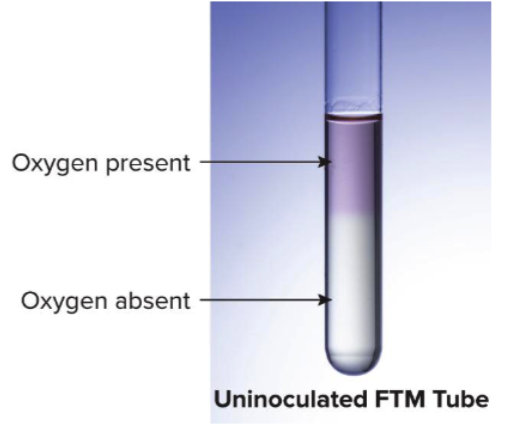Microbial Growth
1/21
There's no tags or description
Looks like no tags are added yet.
Name | Mastery | Learn | Test | Matching | Spaced |
|---|
No study sessions yet.
22 Terms
environmental factors that affect growth and survival rate
atmospheric gases, temp, pH, radiation, osmotic pressure, avail to nutrients
environmental factors that affect the function of metabolic enzymes
high temp and low pH, enzymes are proteins so these factories disrupt their protein structures making them unable to function
environmental lab condition factors that are affect microbial growth
incubators with optimal growth temp., anaerobe jar, refrigerator and freezers
Fluid thioglycollate medium
liquid medium used to support growth of aerobic and anaerobic organisms. has indicator pink when o2 is present in median container, small agar to localize organisms, yellow low o2, white not o2,

obligated aerobes
grow on surface of FTM where o2 is high, O2 to grow, cloudy on top?
obligate anaerobes
will only grow deep in the bottom of FTM tube where oxygen is absent, cloudy near the bottom, must be grown in anaerobic jar
facultative anaerobes
grow throughout FTM tube, appears cloudy throughout because they can grow in anaerobic and aerobic conditions
microaeophiles
small thing band near but not at top
anaerobe jar
oxygen free environment, chemical catalyze run activated to remove free oxygen and indicator strip verifies anaerobic conditions inside
cardinal temps a microbe can survive
optimum, minimum, maximum
optimum
small range of temp in which microbe experience fastest rate of metabolism and growth
min and max
temps extreme boundaries for the survival of an organusm
below minimum temp
organisms metabolic activities are inhibited, mem loses fluidity for transport and growth, cannot continue until temp rises
above maximum temp
irreversible renature of an organisms enzymes occurs and results in death
turbidity
none= no growth, slight = some growth, very = high growth, reliant on temp.
temp can affect growth and phenotype, Serratia Martens
at 25C re protein pigement agross small part, 38C cannot produce this pigment
acid pH level
<7
alkaline
7<
if pH levels are outside of organisms survival range
proteins can denature and result in cell death
isotonic
equal solute concentration to cell, water moves in and out at similar rates, no change in cell volume
hypotonic
lower solute concentration than cell, water moves into cell
hypertonic
higher solute concentration, water leaves cell, bacterial mem will shrink